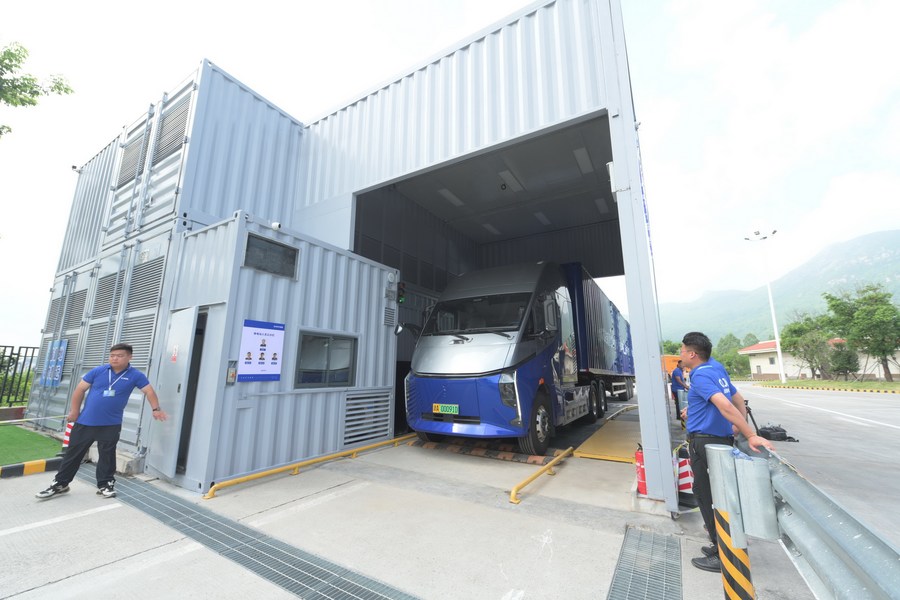China a thriving test ground for NEV technologies

A heavy truck gets its battery swapped at a battery-swapping station in an expressway service area in Fuzhou, southeast China's Fujian Province, Aug. 24, 2023. (Xinhua/Lin Shanchuan)
FUZHOU, Oct. 4 (Xinhua) -- After a heavy truck pulled in, a pair of robotic arms emerged from the ground to pluck out the battery pack from the vehicle's chassis. A moment later, the robotic arms reemerged with a fully-charged battery pack for installation.
This five-minute battery swapping procedure took place at an expressway service area in Fuzhou, southeast China's Fujian Province. It required no human intervention, allowing truck driver Peng Shunqian time to take a short break.
Peng, 50, had driven diesel trucks for years but switched to an electric vehicle (EV) a year ago to reduce fuel costs.
"Compared with diesel ones, this new-energy truck can save me 300-400 yuan (42-55 U.S. dollars) a day. It is easier to drive and more environmentally friendly," he said.
Though battery swapping is not a new concept for EVs, the project Peng is participating in is trailblazing -- it is China's first expressway equipped with battery-swap stations for heavy trucks along its line.
The 420-km expressway linking Ningde and Xiamen has four battery-swap stations, launched in late August to serve a fleet of 100 electric heavy trucks. The stations were built by Chinese battery giant Contemporary Amperex Technology Co., Ltd. (CATL) and Fujian Expressway Group Co., Ltd.
"There are more than 9 million heavy trucks running on China's expressways. Accounting for only 3 percent of the country's total vehicle number, heavy trucks emit more than 40 percent of the carbon emissions (of vehicles in China)," said Zeng Yuqun, board chairman of CATL, who hailed the green potential of the battery-swapping highway.
China aims to peak its carbon dioxide emissions by 2030. This goal has prompted the country, which has the largest number of motor vehicles in the world, to reduce the carbon footprint of traffic and transportation by encouraging a host of new-energy vehicle (NEV) technologies and applications.
Emerging as a solution to EV's slow charging process, battery swapping can be completed in minutes and allows unloaded cells to be charged in off-peak periods to benefit the health of the grid, said Ouyang Chuying, CATL co-president for research and development.
"The idea of battery swapping also encourages the use of EVs, as the expensive battery packs can now be rented instead of being a must-buy item," he said.
In several Chinese cities including Xiamen, Fuzhou, Guiyang and Hefei, CATL's battery swapping stations have started to serve passenger cars, according to Ouyang. "We believe it is the future of EV," he said.
This technology is also making strides in highway transportation. Battery-swapping trucks using the Ningde-Xiamen line are expected to increase to 300 next year, while Fujian's traffic authority has planned to install battery-swapping stations on all the province's expressways as of 2025.
China is the world's largest NEV producer and market. In the first seven months of this year, China saw its NEV sales surge 41.7 percent year on year to 4.53 million units, official data showed.
In its latest work plan for the auto industry, the Chinese government said it aims to bring this year's NEV sales to 9 million units, an increase of 30 percent year on year. It also said testing of full vehicle electrification for public transportation will be started in pilot zones.
In addition, the country is focused on boosting the construction of charging infrastructure, especially in the vast countryside, to promote the use of NEVs in the rural market, according to a government guideline released in May.
Industry observers say the vast domestic market and strong government commitment have combined to push Chinese NEV companies to the global forefront of technological innovation.
Ningde-based CATL, for instance, has revealed plans to mass produce its new lithium iron phosphate (LFP) battery "Shenxing" by the end of this year. It allows for "superfast charging" capable of delivering 400 kilometers of driving range with a 10-minute charge.
At the Smart China Expo 2023 held in September, Chinese EV start-up Xpeng displayed its battery-powered flying car X2, capable of flying to a maximum height of 1,000 meters. The two-seater EV received an official certification for flight safety in January this year.
"In the NEV sector, China boasts advanced corporate technologies, abundant application scenarios and a supportive legal framework," said Ouyang.
"Most importantly, China has seized the historic opportunity to develop the NEV sector at a time when traditional automobile giants lack impetus to embrace NEVs. This is key to the sector's rapid development."
Photos
Related Stories
Copyright © 2023 People's Daily Online. All Rights Reserved.









